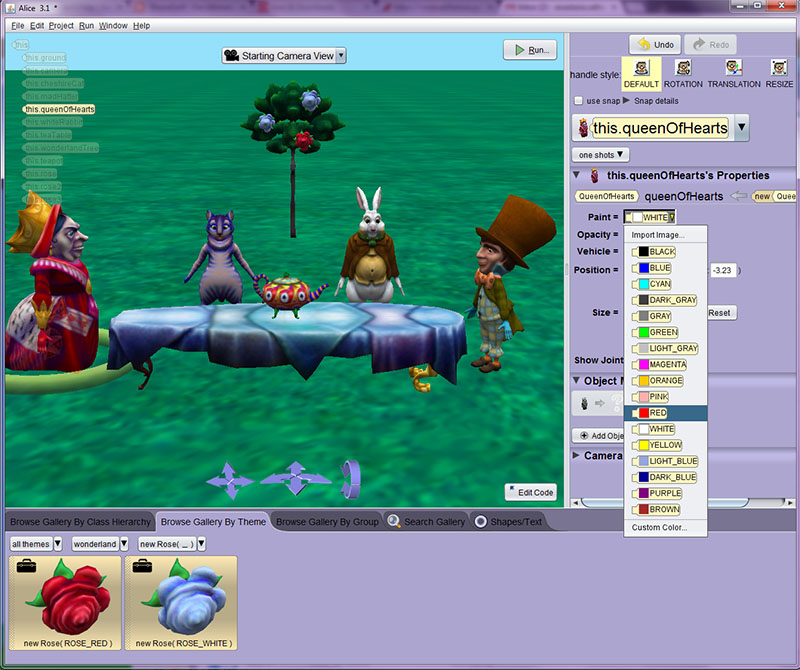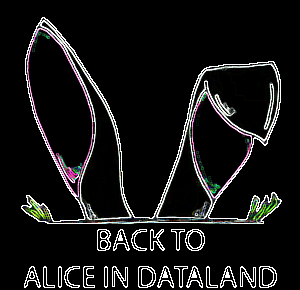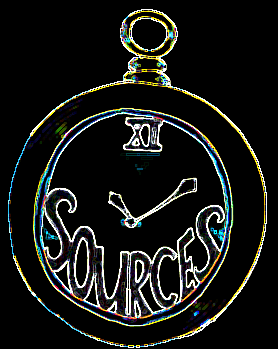XI: Worlds
Code is the use of words to create worlds. Taking words away from sentences, paragraphs, and pages gives us an idea of the content of a work, but not the structure: likewise, the words of code (function, variable, object) lack the power to create without corresponding rules and order. Of Alice's many current incarnations, one of the most interesting is as a system for creating worlds from words. Carnegie Mellon University's Alice, currently on its third version, offers a visual entry-point into coding (not unlike MIT's Scratch, but with a focus on 3D).
Below is a screenshot from the most recent version of Alice. It is a tea-party scene created using several of Alice's built-in Wonderland objects, all themed to allow users to place the familiar objects and provide for them new rules, mechanics, and interactions. The system of representation at work links this incarnation of Alice to the video games of American McGee, but in this case, the Wonderland characters come only with what backstory the user-creator decides to imbue. Here, the most iconic figures of Wonderland gather for a tea party or a trial—who can say, as long as the roses are red?

The original Alice system was designed for complete novices. A modified version called Storytelling Alice offered more support for animations and social interactions between characters with story-based tutorials, and proved more successful with middle school girls at introducing programming. Alice is a gateway to the understanding of the idea of coding, if not all of its technical demands at higher levels. This recalls Rushkoff's Program or Be Programmed: Ten Commands for a Digital Age as he argues: "Understanding programming—either as a real programmer or even, as I'm suggesting, as more of a critical thinker—is the only way to truly know what's going on in a digital environment, and to make willful choices about the roles we play" (8). Rushkoff's description of the "willful choices" of the critical thinker could be a description of Alice herself. Peter Hunt suggests that Alice is still "fresh" because of that willfulness: "We react as much to the attitude as to the content" (28). This is perhaps also emblematic of the digital humanities: not remotely new, but "fresh."
Matt Kirschenbaum noted the increasing visibility of code in his call for humanities programming education: "the distinction between what's on the screen (or page) and what lies beneath is beginning to disappear, as computer languages seep into the visible, legible spaces in which we read." He charts the similarities in world-building with language in general (similarities that can be seen in action in natural language coding, such as Inform 7): "Programming is about choices and constraints, and about how you choose to model some select slice of the world around you in the formal environment of a computer... Those models are made of words and symbols which, by their nature, can be intimidating. To the uninitiated, a computer program is inscrutable, illegible"—like the rules of Wonderland's court, or the digital rain of the Matrix.
"I wish you wouldn't squeeze so." said the Dormouse, who was sitting next to her. "I can hardly breathe."
"I can't help it," said Alice very meekly: "I'm growing."
"You've no right to grow here," said the Dormouse.
"Don't talk nonsense," said Alice more boldly: "you know you're growing too."
"Yes, but I grow at a reasonable pace," said the Dormouse: "not in that ridiculous fashion."
As we near the end of Alice's journey, she is growing once more: too big to be confined to the courtroom or held to the rules of trial in the Queen's mockery of a court. Likewise, Neo outgrows his Wonderland—he begins as a programmer of systems within the Matrix, and becomes a programmer capable of manipulating the entire system of words, code, and worlds.

